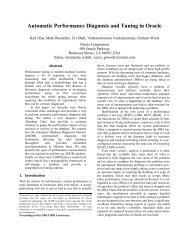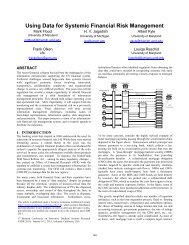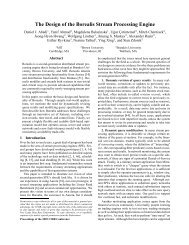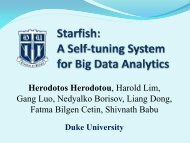SwissBox: An Architecture for Data Processing Appliances
SwissBox: An Architecture for Data Processing Appliances
SwissBox: An Architecture for Data Processing Appliances
You also want an ePaper? Increase the reach of your titles
YUMPU automatically turns print PDFs into web optimized ePapers that Google loves.
possible. Barrelfish extends this philosophy to the multicore case<br />
through the use of distributed capabilities. The resulting OS retains<br />
responsibility <strong>for</strong> securely multiplexing resources among applications,<br />
but presents them to applications in an “unabstracted”<br />
<strong>for</strong>m, together with efficient mechanisms to support the application<br />
managing these resources internally. To take two examples<br />
very relevant to databases, CPU cores are allocated to an application<br />
through upcalls, rather than transparently resuming a process,<br />
allowing fine-grained and efficient application-level scheduling of<br />
concurrent activities, and page faults are vectored back to applications,<br />
which maintain their own page tables, enabling flexible<br />
application management of physical memory.<br />
Beyond this, the use of a flexible research OS within <strong>SwissBox</strong><br />
opens up the exciting possibility of OS-<strong>Data</strong>base codesign: architecting<br />
both the operating system and the data processing application<br />
at the same time. Such opportunities are rare, and the design of<br />
the appropriate interface between an OS and the data storage and<br />
processing layers in <strong>SwissBox</strong> is an exciting research direction. For<br />
instance, the <strong>SwissBox</strong> storage layer knows well the read/write patterns<br />
it generates, and we are exploring how to pass that in<strong>for</strong>mation<br />
to the OS so that the OS can made intelligent decisions rather<br />
than getting on the way or having to “second guess” the application.<br />
Similarly, from those patterns the OS could derive copy on<br />
write optimizations to facilitate recovery and seamless integration<br />
of the main memory storage layer with a file system.<br />
4. STORAGE LAYER<br />
The storage layer in <strong>SwissBox</strong> is based on Crescando, a data<br />
management system designed <strong>for</strong> the Amadeus use case [16]. In<br />
<strong>SwissBox</strong>, we use a distributed version of Crescando as the storage<br />
layer because of its predictable per<strong>for</strong>mance and easy scalability.<br />
It also establishes the basis <strong>for</strong> exploring completely new database<br />
architectures that provide high consistency, exploit the availability<br />
of main memory, while still enabling the levels of elasticity and<br />
scalability needed in large applications.<br />
In <strong>SwissBox</strong>, the interface to the storage manager is at the level<br />
of tuples rather than at the level of disk/memory blocks. Similarly,<br />
rather than simple get and puts over blocks, the storage is<br />
accessed via predicates over tuples. This greatly facilitates pushing<br />
part of the query processing down to the storage layer and makes<br />
the storage manager an integral part of the data processing system<br />
not just an abstraction over disk storage. This design choice is crucial<br />
to make <strong>SwissBox</strong> open to further hardware developments and<br />
to provide the same interface regarding of the hardware (or hardware<br />
layers) behind the storage manager.<br />
Briefly described, Crescando works as a collection of data processing<br />
units at the core level. The storage manager works entirely<br />
in main memory, using clusters of machines <strong>for</strong> scalability and<br />
replication <strong>for</strong> fault tolerance. Each core continuously scans its<br />
main memory (hence the name clock scan), using an update cursor<br />
and a read cursor where queries and updates are attached in every<br />
cycle. Instead of indexing the data, Crescando dynamically indexes<br />
the queries to speed up checking each record against all outstanding<br />
queries. The latency guarantees of Crescando are determined<br />
by the time it takes to complete a scan. In current hardware, Crescando<br />
can scan 1.5 GBytes per core in less than a second, answering<br />
thousands of queries per cycle and core, even under a heavy<br />
update load. Within a scan, Crescando maintains the equivalent of<br />
snapshot isolation, with consistency across the whole system being<br />
maintained by e-cast, an agreement protocol specifically developed<br />
<strong>for</strong> Crescando (see below).<br />
Crescando partitions the data into segments that are placed into<br />
the local memory of a single core. The segments can be replicated<br />
across cores and/or across machines, depending on the configuration<br />
chosen. For availability, Crescando maintains several copies of<br />
each segment across different machines so that if one fails, the segment<br />
is still available at a different node. Recovery in Crescando<br />
only requires to place the corresponding data in the memory of the<br />
recovered machine.<br />
To understand the advantages of Crescando, it is important to<br />
understand how it differs from a conventional engine. For single<br />
queries over indexed attributes, Crescando is much slower than a<br />
conventional engine. However, as soon as a query requires a full<br />
table scan or there are updates, Crescando per<strong>for</strong>ms much better<br />
and with more stability than conventional engines. In other words,<br />
Crescando trades-off single, one at a time query per<strong>for</strong>mance <strong>for</strong><br />
predictability (in Crescando all queries and updates are guarantee<br />
to complete within a scan period) and throughput (Crescando is<br />
optimized <strong>for</strong> running thousands of queries in parallel).<br />
When compared to existing appliances, the storage layer of Swiss-<br />
Box offers several advantages.<br />
As in Exadata, Crescando is an intelligent storage layer that can<br />
process selection and projection predicates, as well as exact match<br />
and range queries. This eliminates a lot of unnecessary traffic<br />
from the network and offers the first opportunity within <strong>SwissBox</strong><br />
<strong>for</strong> pushing down operators close to the source. Unlike Exadata,<br />
in <strong>SwissBox</strong> we do not need an extra function shipping module<br />
or extra code at the storage layer. The storage layer is built directly<br />
as a query processor that can be easily tuned to match any<br />
latency/throughput requirements with two simple parameters (the<br />
size of a scan and the level of replication).<br />
Like in SAP’s BWA, the storage layer of <strong>SwissBox</strong> processes<br />
data in main memory, avoiding the overhead of data transfer from<br />
disk. In <strong>SwissBox</strong>, indexes are not used and the database administrator<br />
does not need to worry about identifying which ones are<br />
needed. This is an important point as one of the motivations <strong>for</strong>,<br />
e.g., SAP’s BWA is to provide per<strong>for</strong>mance in spite of the fact that<br />
users are likely to chose the wrong indexes and data organization<br />
(and this is why BWA reorganizes the data). In the future, the main<br />
memory approach of <strong>SwissBox</strong> is ideally suited to quickly adopt<br />
Phase Change Memory, thereby combining the advantages of in<br />
memory processing with persistent storage.<br />
In terms of cross layer optimizations, the design of Crescando<br />
fits very well with the premises behind Barrelfish. Crescando can<br />
use the interfaces provided by Barrelfish to make runtime decisions<br />
on placement and scheduling. The data storage layer can also be<br />
combined with modern networking techniques such as RDMA (Remote<br />
Direct Memory Access) [7]. Through RDMA, a node can<br />
place data directly in the memory of another node without involving<br />
the operating system and minimizing copying of the data. This<br />
is a feature that is commonly available in high end networks like<br />
Infiniband (the network used in Oracle Exadata) but that is now<br />
available through special network cards also <strong>for</strong> Ethernet networks.<br />
Using RDMA, recovery of nodes, data reorganization, and dynamic<br />
creation of copies can be greatly accelerated over traditional approaches.<br />
For instance, there is some initial work on rethinking the<br />
processing of data joins using RDMA [8].<br />
As an alternative design option, we are also exploring using a<br />
similar one-scan-per-core approach but on a column store (as in<br />
SAP’s BWA). Initial experiments indicate that column stores in<br />
main memory allow interesting and quite effective optimizations<br />
even if no disk access is involved. <strong>An</strong> intriguing idea that can be<br />
easily supported by the <strong>SwissBox</strong> storage layer is to store the data<br />
both row-wise and column-wise, routing queries to the most appropriate<br />
representation.<br />
35








